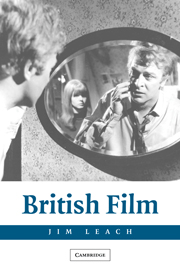Book contents
- Frontmatter
- Contents
- Acknowledgments
- Introduction
- 1 The National Health: Great Britain/Deep England
- 2 The Magic Box: What Is British Cinema?
- 3 The Common Touch: The Art of Being Realistic
- 4 The Mirror Crack'd: British Expressionism
- 5 Millions like Us: National Cinema as Popular Cinema
- 6 The Stars Look Down: Acting British
- 7 No Sex Please – We're British: Sex, Gender, and the National Character
- 8 Carry On Regardless: The British Sense of Humor
- 9 Sexy Beasts: British Monsters
- 10 The Ruling Class: Ideology and the School Movie
- 11 The Long Memory: History and Heritage
- 12 I'm British but … : Empire and After
- Notes
- Bibliography
- Filmography
- Index
4 - The Mirror Crack'd: British Expressionism
Published online by Cambridge University Press: 07 May 2010
- Frontmatter
- Contents
- Acknowledgments
- Introduction
- 1 The National Health: Great Britain/Deep England
- 2 The Magic Box: What Is British Cinema?
- 3 The Common Touch: The Art of Being Realistic
- 4 The Mirror Crack'd: British Expressionism
- 5 Millions like Us: National Cinema as Popular Cinema
- 6 The Stars Look Down: Acting British
- 7 No Sex Please – We're British: Sex, Gender, and the National Character
- 8 Carry On Regardless: The British Sense of Humor
- 9 Sexy Beasts: British Monsters
- 10 The Ruling Class: Ideology and the School Movie
- 11 The Long Memory: History and Heritage
- 12 I'm British but … : Empire and After
- Notes
- Bibliography
- Filmography
- Index
Summary
Film historians often distinguish between a realist tradition, descending from the brief actualités of the Lumière brothers, and another tradition, often loosely described as “expressionist,” traced back to the magical fantasies of Georges Méliès. This distinction is in many ways a problematic one, not least because it tends to encourage the idea that realism is the norm, but these broad categories can be useful as long as it is recognized that they refer to tendencies rather than mutually exclusive stylistic options. They inevitably coexist in all films, and the allegiance to one or other approach is a matter of emphasis, with the result that many films seem to belong equally to both traditions. Citizen Kane (Orson Welles, 1941) is one celebrated example of a film whose realism, stressed by critics like Andre Bazin, exists in a complex relationship with expressionist techniques. As discussed in the previous chapter, Brief Encounter is another.
Most realist filmmakers would accept Bazin's definition of realism as an aesthetic in which “the image is evaluated not according to what it adds to reality but what it reveals of it.” From this perspective, the expressionist tendency involves the creation of images that add to reality by using cinematic techniques such as lighting, camera angle, and montage to express a distinctive view of reality. Bazin assumes that the image can reveal reality by making us aware of things that are visible but may have escaped our attention. The expressionist tradition seeks to go beyond what is visible and stresses the power of the imagination.
- Type
- Chapter
- Information
- British Film , pp. 66 - 85Publisher: Cambridge University PressPrint publication year: 2004

